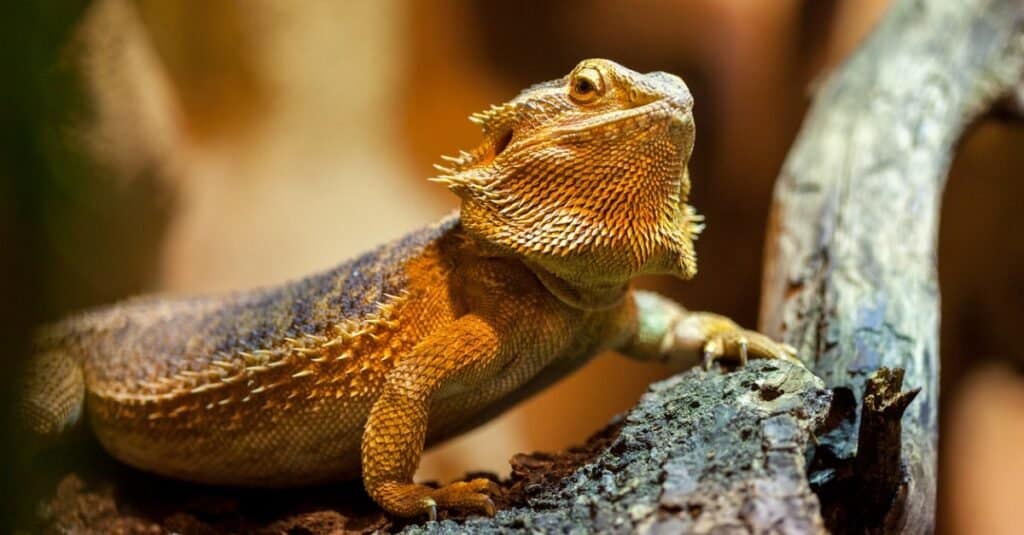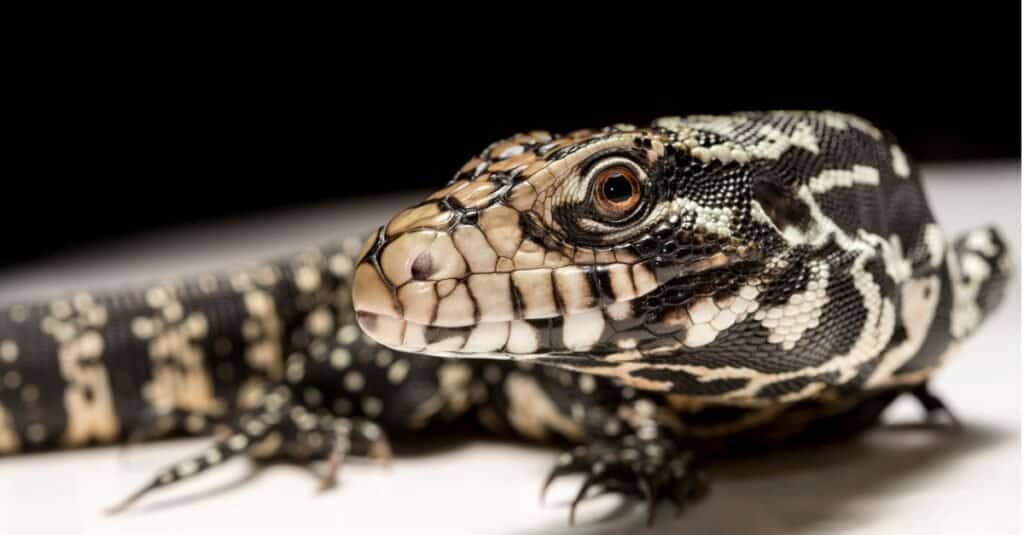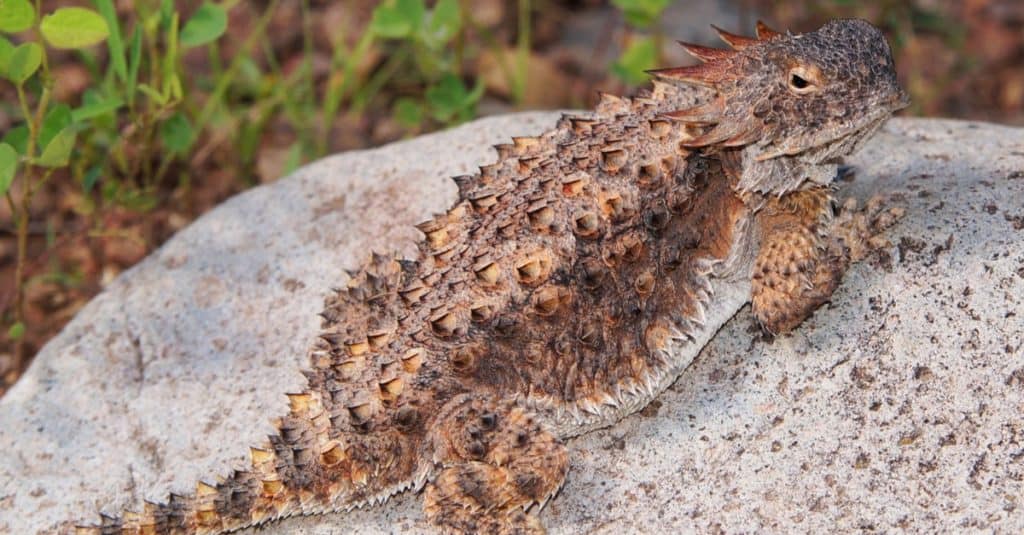All animals have to maintain their core body temperature somehow for their bodily processes like digestion, growth, and respiration to run smoothly. You’ve likely heard at some point that all animals are either warm-blooded or cold-blooded. But what do these terms actually mean, particularly for our scaly friends? Are reptiles warm-blooded or cold-blooded?
Let’s take an in-depth look at how reptiles manage to keep their bodies warm and functioning properly.
What Does it Mean to be “Cold-Blooded?”

Nearly all reptiles, such as this
bearded dragon
, are cold-blooded.
©iStock.com/huettenhoelscher
“Cold-blooded” is an informal term that generally refers to animals that are ectothermic rather than endothermic.
However, before we get into precisely what endothermy and ectothermy entail, it’ll help to briefly touch on what thermoregulation is, why it’s important in this context, and how it works. Essentially, all animals must thermoregulate or keep their body temperature within a specific range to maintain homeostasis.
To put it simply, homeostasis is a state of internal stability that allows an animal’s bodily functions to play out normally. This involves various factors, such as optimal fluid levels, blood pressure, and body temperature. A stable body temperature is one of the most important factors in maintaining homeostasis. Most animals are either ectothermic or endothermic when it comes to how they maintain their core body temperature.
An ectothermic or “cold-blooded” animal must rely on its external environment and surroundings to raise or lower its body temperature. For instance, an ectothermic animal might bask in the sunlight to warm up. Alternatively, it might dig a burrow for itself in some sand to cool down.
On the other hand, endothermic or “warm-blooded” animals create their body heat. They release heat sort of as a byproduct of their internal processes. As an endothermic animal digests, breathes, reproduces, and generally goes about its daily life, its body maintains its ideal temperature on its own. If the animal becomes particularly cold or hot, though, it might rely on additional behaviors like shivering or sweating to help further stabilize its temperature.
Are All Reptiles Cold-Blooded?

Argentine black and white tegus are capable of partial endothermy.
©iStock.com/Rafael Cutó
As we touched on above, all animals are either ectothermic or endothermic. Ectothermic animals are generally considered “cold-blooded,” while endothermic animals are considered “warm-blooded.”
In general, most reptiles, amphibians, fish, and insects are ectothermic or cold-blooded. As a result, they have to rely on their environment to keep their bodies warm and functioning properly. Birds and mammals, on the other hand, are almost exclusively endothermic.
Currently, there are no fully endothermic reptiles. However, a small handful of certain fish, insects, and reptiles are at least partially endothermic. This means they can maintain their body temperature internally only temporarily in very specific circumstances.
Interestingly, the Argentine black and white tegu lizard is a notable outlier here. When they undergo brumation (the cold-blooded animal’s version of hibernation), their metabolisms temporarily give off heat in a similar way to endothermic animals. This allows them to raise their body temperature slightly to stay warm in this particular state. Outside of brumation, though, they are ectothermic as usual, like other reptiles.
A few species of pythons can also become temporarily endothermic in very specific conditions. Indian rock pythons and carpet pythons sometimes undergo a type of endothermy known as facultative endothermy. This allows them to produce additional body heat by exercising or moving a certain way. After laying eggs, these pythons will flex their abdominal muscles and “shiver” rapidly to temporarily raise their body temperature. In turn, they can incubate their eggs more efficiently.
However, these exceptions, as fascinating as they are, are rare and only temporary. All reptiles are either fully or mostly ectothermic.
How Do Reptiles Thermoregulate?

Horned lizards often bask atop warm rocks to raise their body temperature.
©Matt Jeppson/Shutterstock.com
Since reptiles are typically ectothermic or cold-blooded, they have to get a bit creative with how they keep their body temperature consistent and warm. While endothermic animals can thermoregulate passively, ectotherms have to rely on their environment to regulate their temperature. There are many ways they can cleverly use their surroundings to increase or decrease their internal temperature when needed.
For example, if it’s a particularly cold day and a lizard isn’t warm enough, it might bask under direct sunlight on a dark, flat rock. This will allow it to absorb more warmth from the sun overhead as well as the direct belly heat from the rock itself.
Many lizards, such as bearded dragons and horned lizards, can extend their ribs and “flatten” themselves out to increase their body’s surface area. As a result, they can absorb more sunlight and warmth than usual when they’re in dire need of a quick increase in body temperature.
Alternatively, a snake may take a swim in some cool waters under a shady tree to cool down on a very hot day. Similarly, tortoises will dig burrows in cool, moist sand to quickly and easily lower their body temperature when necessary.
In short, there are a lot of ways reptiles can increase or decrease their temperature in a pinch. It’s certainly not as convenient as being endothermic, but it works!
The photo featured at the top of this post is © Matt Jeppson/Shutterstock.com
Thank you for reading! Have some feedback for us? Contact the AZ Animals editorial team.







